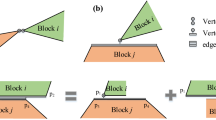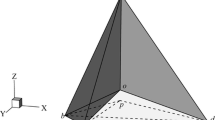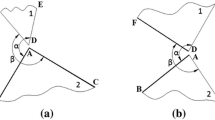Abstract
Edge-to-edge contact is a fundamental contact type in blocky systems. In two-dimensional discontinuous deformation analysis (2D DDA, and hereinafter DDA for short), an edge-to-edge contact is transformed into two separated vertex-to-edge contacts by applying two pairs of concentrated springs. Although this simplification facilitates the DDA algorithm, it is not always sufficiently accurate and can even yield irregular results. To solve this problem, a distributed-spring contact model (DSCM) that exerts distributed instead of concentrated forces on contact edges is proposed in this paper for the edge-to-edge contact in DDA. Submatrices for the force matrix and stiffness matrix are obtained by minimizing the potential energy of the distributed contact forces and are incorporated into an improved DDA (I-DDA) code. Four examples are evaluated to illustrate the validations and advantages of the I-DDA. The first example is a single square impacting on a base block. Deformation of the contact area is evaluated by comparison with the theoretical deformation solution, and the results calculated by the I-DDA show better agreement with the analytical solution than the original DDA (O-DDA). The second example is an impact validation, proving that the I-DDA is more adaptable to discrete systems containing blocks of different sizes. Then an example and an experiment about block rebounding are provided, demonstrating that the errors in rotation and rebounding exhibited in the O-DDA results are avoided when using the I-DDA, indicating that the I-DDA provides more realistic solutions. The results of this study suggest that the proposed I-DDA incorporating the DSCM is quite accurate and capable of improving calculation accuracy compared to the O-DDA.





















Similar content being viewed by others
Abbreviations
- d, h :
-
Penetration depth
- D i :
-
Displacement matrix of block i
- E :
-
is the elastic modulus
- εx, εy :
-
x-wise and y-wise strains
- F i :
-
Loading vector of block i
- F′i :
-
Component of Fi
- F1–F4 :
-
Normal contact spring forces
- g :
-
Gravitational acceleration
- k :
-
Contact spring stiffness
- K :
-
Stiffness submatrix
- K′:
-
Component of K
- l :
-
Length of the entrance edge
- p :
-
Distributed spring force per edge length per penetration depth
- p d :
-
Distributed force
- Π:
-
Potential energy
- r 0 :
-
Dotation of point (x0, y0)
- ρ :
-
Density
- S :
-
Area
- Sc, Sd :
-
Average deformation
- s1–s4 :
-
Edge length
- t11–t26 :
-
Elements of [Ti]
- [Ti]:
-
Displacement transformation matrix
- u 0 :
-
x-wise displacement of point (x0, y0)
- v :
-
Poisson’s ratio
- v 0 :
-
y-wise displacement of point (x0, y0)
- γ xy :
-
Shear strain
- DDA:
-
Discontinuous deformation analysis
- DSCM:
-
Distributed-spring contact model
- FEM:
-
Finite element method
- I-DDA:
-
Improved DDA by incorporating DSCM
- O-DDA:
-
Original DDA
References
Bakun-Mazor D, Hatzor YH, Glaser SD (2012) Dynamic sliding of tetrahedral wedge: the role of interface friction. Int J Numer Anal Methods Geomech 36:327–343. https://doi.org/10.1002/nag.1009
Bao HR, Zhao ZY (2010) An alternative scheme for the corner–corner contact in the two-dimensional discontinuous deformation analysis. Adv Eng Softw 41:206–212. https://doi.org/10.1016/j.advengsoft.2009.09.007
Bao HR, Zhao ZY (2012) The vertex-to-vertex contact analysis in the two-dimensional discontinuous deformation analysis. Adv Eng Softw 45:1–10. https://doi.org/10.1016/j.advengsoft.2011.09.010
Bao HR, Hatzor YH, Huang X (2012) A new viscous boundary condition in the two-dimensional discontinuous deformation analysis method for wave propagation problems. Rock Mech Rock Eng 45:919–928. https://doi.org/10.1007/s00603-012-0245-y
Beyabanaki SAR, Ferdosi B, Mohammadi S (2009) Validation of dynamic block displacement analysis and modification of edge-to-edge contact constraints in 3-D DDA. Int J Rock Mech Min 46:1223–1234. https://doi.org/10.1016/j.ijrmms.2008.12.001
Chen GQ, Zheng L, Zhang YB, Wu J (2013) Numerical simulation in rockfall analysis: a close comparison of 2-D and 3-D DDA. Rock Mech Rock Eng 46:527–541. https://doi.org/10.1007/s00603-012-0360-9
Cheng YM (1998) Advancements and improvement in discontinuous deformation analysis. Comput Geotech 22:153–163. https://doi.org/10.1016/S0266-352X(98)00002-0
Cheng YM, Zhang YH (2000) Rigid body rotation and block internal discretization in DDA analysis. Int J Numer Anal Methods Geomech 24:567–578. https://doi.org/10.1002/(Sici)1096-9853(200005)24:6%3c567:Aid-Nag83%3e3.0.Co;2-N
Doolin DM (2005) Unified displacement boundary constraint formulation for discontinuous deformation analysis (DDA). Int J Numer Anal Methods Geomech 29:1199–1207. https://doi.org/10.1002/nag.454
Fan H, He SM (2015) An angle-based method dealing with vertex–vertex contact in the two-dimensional discontinuous deformation analysis (DDA). Rock Mech Rock Eng 48:2031–2043. https://doi.org/10.1007/s00603-014-0692-8
Fu XD, Sheng Q, Zhang YH, Zhou YQ, Dai F (2015) Boundary setting method for the seismic dynamic response analysis of engineering rock mass structures using the discontinuous deformation analysis method. Int J Numer Anal Methods Geomech 39:1693–1712. https://doi.org/10.1002/nag.2374
Fu GY, Ma GW, Qu XL (2017a) Boundary element based discontinuous deformation analysis. Int J Numer Anal Methods Geomech 41:994–1015. https://doi.org/10.1002/nag.2661
Fu XD, Sheng Q, Zhang YH, Chen J, Leng XL (2017b) Extension of the discontinuous deformation analysis method to simulate seismic response of a large rock cavern complex. Int J Geomech 17:89. https://doi.org/10.1061/(Asce)Gm.1943-5622.0000712
Grayeli R, Hatami K (2008) Implementation of the finite element method in the three-dimensional discontinuous deformation analysis (3D-DDA). Int J Numer Anal Methods Geomech 32:1883–1902. https://doi.org/10.1002/nag.704
Grayeli R, Mortazavi A (2006) Discontinuous deformation analysis with second-order finite element meshed block. Int J Numer Anal Methods Geomech 30:1545–1561. https://doi.org/10.1002/nag.538
Hatzor YH (1999) Dynamic rock slope stability analysis at Masada national monument using Block Theory and DDA. Rock Mech Ind 1:63–70
Hatzor YH, Arzi AA, Zaslavsky Y, Shapira A (2004) Dynamic stability analysis of jointed rock slopes using the DDA method: King Herod’s Palace, Masada, Israel. Int J Rock Mech Min 41:813–832. https://doi.org/10.1016/j.ijrmms.2004.02.002
Jiao YY, Zhang XL, Zhao J, Liu QS (2007) Viscous boundary of DDA for modeling stress wave propagation in jointed rock. Int J Rock Mech Min 44:1070–1076. https://doi.org/10.1016/j.ijrmms.2007.03.001
Ke T-C (1995) Modification of DDA with respect to rigid body rotation. In: Proceedings of the first international conference on analysis of discontinuous deformation. Chungli, Taiwan, ROC: National Central University, 1995, pp 260–273
Liu J, Nan Z, Yi P (2012) Validation and application of three-dimensional discontinuous deformation analysis with tetrahedron finite element meshed block. Acta Mech Sin 28:1602–1616. https://doi.org/10.1007/s10409-012-0153-0
Ma YZ, Cai KJ, Li ZT, Song CX (2014) Modeling slope anchor reinforcement using enhanced discontinuous deformation analysis method (EDDA) with natural neighbor interpolation. Appl Mech Mater 638:680–683. https://doi.org/10.4028/www.scientific.net/AMM.638-640.680
Ma SQ, He C, Zhao ZY, Nie W, Zhu X, Zhang ZY (2017a) Modeling of rock joints under cyclic loading conditions using discontinuous deformation analysis. Rock Mech Rock Eng 50:1205–1215. https://doi.org/10.1007/s00603-016-1158-y
Ma SQ, Zhao ZY, Nie W, Nemcik J, Zhang ZY, Zhu X (2017b) Implementation of displacement-dependent Barton–Bandis rock joint model into discontinuous deformation analysis. Comput Geotech 86:1–8. https://doi.org/10.1016/j.compgeo.2016.12.030
MacLaughlin MM, Doolin DM (2006) Review of validation of the discontinuous deformation analysis (DDA) method. Int J Numer Anal Methods Geomech 30:271–305. https://doi.org/10.1002/nag.427
MacLaughlin M, Sitar N (1996) Rigid body rotations in DDA. In: Proceedings of the first international forum on discontinuous deformation analysis (DDA) and simulation of discontinuous media, Berkeley, 1996, pp 620–635
Ning YJ, Zhao ZY (2013) A detailed investigation of block dynamic sliding by the discontinuous deformation analysis. Int J Numer Anal Methods Geomech 37:2373–2393. https://doi.org/10.1002/nag.2140
Ohnishi Y, Yamamukai K, Chen GQ (1996) Application of DDA in rock fall analysis. Rock Mech Tools Tech 1:2031–2037
Peng X, Yu P, Zhang Y, Chen G (2018) Applying modified discontinuous deformation analysis to assess the dynamic response of sites containing discontinuities. Eng Geol 246:349–360. https://doi.org/10.1016/j.enggeo.2018.10.011
Peng X et al (2019a) Parallel computing of three-dimensional discontinuous deformation analysis based on OpenMP. Comput Geotech 106:304–313. https://doi.org/10.1016/j.compgeo.2018.11.016
Peng X, Chen G, Yu P, Zhang Y, Wang J (2019b) Improvement of joint definition and determination in three-dimensional discontinuous deformation analysis. Comput Geotech 110:148–160. https://doi.org/10.1016/j.compgeo.2019.02.016shi
Peng X, Yu P, Chen G, Xia M, Zhang Y (2019c) Development of a coupled DDA–SPH method and its application to dynamic simulation of landslides involving solid–fluid interaction. Rock Mech Rock Eng. https://doi.org/10.1007/s00603-019-01900-x
Shi G (1989) Discontinuous deformation analysis a new numerical model for the static and dynamics of block systems. Dissertation, UC, Berkeley, USA
Shi G, Goodman RE (1984) Discontinuous deformation analysis. In: US Symposium on Rock Mechanics, Evanston, Ill, 25 Jun, 1984, pp 790–799
Shi G-H, Goodman RE (1985) Two dimensional discontinuous deformation analysis. Int J Numer Anal Methods Geomech 9:541–556. https://doi.org/10.1002/nag.1610090604
Shi GH, Goodman RE (1989) Generalization of two-dimensional discontinuous deformation analysis for forward modeling. Int J Numer Anal Methods Geomech 13:359–380. https://doi.org/10.1002/nag.1610130403
Song YX, Huang D, Zeng B (2017) GPU-based parallel computation for discontinuous deformation analysis (DDA) method and its application to modelling earthquake-induced landslide. Comput Geotech 86:80–94. https://doi.org/10.1016/j.compgeo.2017.01.001
Sun Y, Feng XC, Xiao J, Wang Y (2016) Discontinuous deformation analysis coupling with discontinuous Galerkin finite element methods for contact simulations. Math Probl Eng. https://doi.org/10.1155/2016/6217679
Tian Q, Zhao ZY, Bao HR (2014) Block fracturing analysis using nodal-based discontinuous deformation analysis with the double minimization procedure. Int J Numer Anal Methods Geomech 38:881–902. https://doi.org/10.1002/nag.2237
Tsesarsky M, Hatzor YH, Sitar N (2005) Dynamic displacement of a block on an inclined plane: analytical, experimental and DDA results. Rock Mech Rock Eng 38:153–167. https://doi.org/10.1007/s00603-004-0043-2
Wang L-z, Jiang H-y, Yang Z-x, Xu Y-c, Zhu X-b (2013) Development of discontinuous deformation analysis with displacement-dependent interface shear strength. Comput Geotech 47:91–101. https://doi.org/10.1016/j.compgeo.2012.06.006
Wang W, Chen GQ, Zhang H, Zhou SH, Liu SG, Wu YQ, Fan FS (2016) Analysis of landslide-generated impulsive waves using a coupled DDA-SPH method. Eng Anal Bound Elem 64:267–277. https://doi.org/10.1016/j.enganabound.2015.12.014
Wang W, Chen GQ, Zhang YB, Zheng L, Zhang H (2017a) Dynamic simulation of landslide dam behavior considering kinematic characteristics using a coupled DDA-SPH method. Eng Anal Bound Elem 80:172–183. https://doi.org/10.1016/j.enganabound.2017.02.016
Wang W, Zhang H, Zheng L, Zhang YB, Wu YQ, Liu SG (2017b) A new approach for modeling landslide movement over 3D topography using 3D discontinuous deformation analysis. Comput Geotech 81:87–97. https://doi.org/10.1016/j.compgeo.2016.07.015
Wang X, Wu W, Zhu H, Lin J-S, Zhang H (2019) Contact detection between polygonal blocks based on a novel multi-cover system for discontinuous deformation analysis. Comput Geotech 111:56–65
Wu JH (2007) Applying discontinuous deformation analysis to assess the constrained area of the unstable Chiu-fen-erh-shan landslide slope. Int J Numer Anal Methods Geomech 31:649–666. https://doi.org/10.1002/nag.548
Wu J-H (2015) The elastic distortion problem with large rotation in discontinuous deformation analysis. Comput Geotech 69:352–364. https://doi.org/10.1016/j.compgeo.2015.06.001
Wu J-H, Do TN, Chen C-H, Wang G (2017) New geometric restriction for the displacement-constraint points in discontinuous deformation analysis. Int J Geomech 17:E4016002. https://doi.org/10.1061/(ASCE)GM.1943-5622.0000648
Yang M, Fukawa T, Ohnishi Y, Nishiyama S, Miki S, Hirakawa Y, Mori S (2004) The application of three-dimensional DDA with a spherical rigid block to rockfall simulation. Int J Rock Mech Min 41:476. https://doi.org/10.1016/j.ijrmms.2003.12.147
Yeung MR, Jiang QH, Sun N (2003) Validation of block theory and three-dimensional discontinuous deformation analysis as wedge stability analysis methods. Int J Rock Mech Min 40:265–275. https://doi.org/10.1016/S1365-1609(02)00137-5
Yu Y, Yin JM (2015) Some modifications to the process of discontinuous deformation analysis. J Rock Mech Geotech Eng 7:95–100. https://doi.org/10.1016/j.jrmge.2014.12.001
Yu P, Zhang Y, Peng X, Wang J, Chen G, Zhao JX (2018) Evaluation of impact force of rock landslides acting on structures using discontinuous deformation analysis. Comput Geotech. https://doi.org/10.1016/j.compgeo.2019.103137
Zhang YB, Xu Q, Chen GQ, Zhao JX, Zheng L (2014) Extension of discontinuous deformation analysis and application in cohesive-frictional slope analysis. Int J Rock Mech Min 70:533–545. https://doi.org/10.1016/j.ijrmms.2014.06.005
Zhang YB et al (2015) DDA validation of the mobility of earthquake-induced landslides. Eng Geol 194:38–51. https://doi.org/10.1016/j.enggeo.2014.08.024
Zhang H, Liu S, Chen G, Zheng L, Zhang Y, Wu Y, Jing P, Wang W, Han Z, Zhong G, Lou S (2016) Extension of three-dimensional discontinuous deformation analysis to frictional-cohesive materials. Int J Rock Mech Min Sci 86:65–79
Zhao ZY, Gu J (2009) Stress recovery procedure for discontinuous deformation analysis. Adv Eng Softw 40:52–57. https://doi.org/10.1016/j.advengsoft.2008.03.003
Zheng H, Jiang W (2009) Discontinuous deformation analysis based on complementary theory. Sci China Ser E Technol Sci 52:2547–2554. https://doi.org/10.1007/s11431-009-0256-4
Acknowledgements
This work was supported by the National Natural Science Foundation of China (Grant numbers 41672286, 51408511, 41530639 and 41761144080), Science and Technology Department of Sichuan Province (Grant number 2017JQ0042). The first and third authors want to thank the China Scholarship Council (CSC) and the Japanese Government (MEXT) Scholarship Program, respectively. The financial supports are gratefully acknowledged.
Author information
Authors and Affiliations
Corresponding author
Ethics declarations
Conflict of interest
The authors declare that they have no conflict of interest.
Additional information
Publisher's Note
Springer Nature remains neutral with regard to jurisdictional claims in published maps and institutional affiliations.
Rights and permissions
About this article
Cite this article
Yu, P., Zhang, Y., Peng, X. et al. Distributed-Spring Edge-to-Edge Contact Model for Two-Dimensional Discontinuous Deformation Analysis. Rock Mech Rock Eng 53, 365–382 (2020). https://doi.org/10.1007/s00603-019-01917-2
Received:
Accepted:
Published:
Issue Date:
DOI: https://doi.org/10.1007/s00603-019-01917-2




